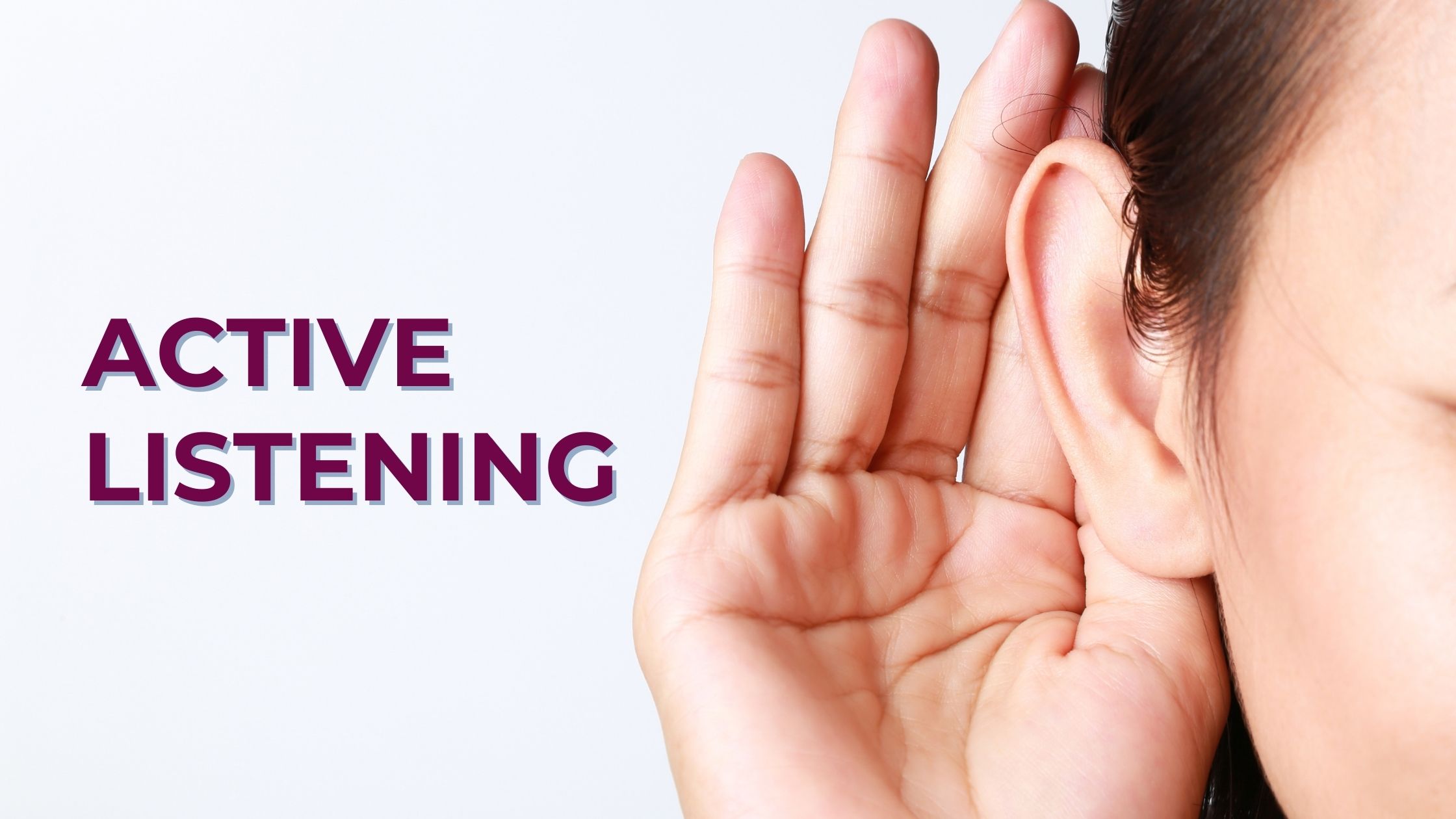To be an effective leader whose teams are productive, happy, collaborative, and working towards the same goal, you must communicate in a manner that ensures people feel heard.
Workplaces are diverse with various beliefs, opinions, political stances, working strategies, and personality types. Recognizing these differences by taking the time to listen to all team members as individuals is a crucial part of being an effective and influential leader.
There may be a million things that you need to do in a day, but making a conscious effort to understand a person’s entire message without looking distracted or disinterested will enhance the respect you receive from your employees.
That is why many leaders are pursuing Active Listening skills. There is a stark difference between leaders who are present and focused in a conversation and those that are not. In this blog, I will explain what Active Listening is, how to use it, and its numerous long-term benefits to your leadership.
What Is Active Listening?
Active Listening is a technique used by a person to communicate successfully with a speaker. The skill requires a lot of practice and rewiring of former communication strategies that are ingrained but ineffective.
An Active Listener is willing to listen and learn about the speaker’s point of view, what they are trying to convey, and how they feel about the topic in question. When leaders use Active Listening skills, they fully communicate with their bodies and voice. Inevitably, your fellow team members will exhibit stronger working relationships with you and a willingness to go the extra mile to get a job done when you use Active Listening.
There are four stages of Active Listening.
Stage 1: Recognizing
Almost everyone can tell the difference between a meaningful conversation and a trivial one. However, to be sure, attempt to cease all other activities or conversations and focus entirely on the speaker giving the message.
If the conversation is clearly of significance, avoid other distractions such as phones and computers and tune into the speaker’s verbal and non-verbal dialogue. If, for whatever reason, you are distracted, acknowledge it and return to receiving their communication.
Stage 2: Understanding
Sometimes the person’s point is hidden when they speak to you, so ensure that you understand by paraphrasing their speech and asking questions without interjecting. Seeking clarification on key points will help the person feel heard.
Stage 3: Evaluating
Once you feel you have understood the speaker’s meaning, confirm their sentiments before beginning your response. Often, when a person feels misunderstood, and nothing is clarified, resentment and anger set in—which is not at all constructive!
Stage 4: Reacting
Acknowledge that you hear the person speaking, and understand how they feel, is your first port of call when using the final stage of Active Listening. Follow this up with a response targeted at everything they have said without veering off course. Don’t make excuses, and be as frank as possible. Finally, ensure the conversation has reached a natural conclusion before moving on.
How Do I Use Active Listening?

Active Listening is not something you just do with your eyes. It requires your whole body. Leaders that successfully use Active Listening techniques in their managerial toolkit do not just listen and respond verbally. Far from it. The key to a robust, productive conversation is ensuring the recipient knows you’ve heard them and understand how they feel.
1. Use Engaging Body Language
Body language is everything in communication, and considering how you use it is critical to a positive outcome. Folding your arms in a defensive position is an obvious body language no-no. Face the speaker with a strong but not overbearing posture. Use friendly hand gestures and nod when you are trying to exhibit understanding. Toe-tapping and finger drumming are, for obvious reasons, not ideal ways to show Active Listening.
2. Assess The Speaker’s Body Language
While recognizing your own body language is essential, so is keeping an eye on what the speaker is doing. How are they behaving? Do they seem nervous or uncomfortable? Considering almost all communication is non-verbal, unconscious movements and how information is transmitted can tell us a lot about how the speaker feels. When you are attuned to their body language you can adjust your communication to make the speaker feel more at ease.
3. Try To Keep Eye Contact
Making eye contact with the speaker is a necessity so that you don’t seem like you want to escape from the situation or that you have somewhere else to be. With that said, too much eye contact can be unnerving and make you appear aloof. I recommend a 50/50 split for the entirety of the conversation—this is a healthy balance.
4. Look For Other Non-Verbal Cues
A person’s intentions may not always come out in speech. An Active listener can notice small non-verbal clues that can help them understand why the speaker is communicating in a certain way. Although it never pays to make wild predictions, those verbal cues can help build a bigger picture. For example, some people may speak rapidly, indicating anxiety and nervousness. Others may try to choose their words carefully by often pausing, indicating a desire to be conciliatory.

5. Ask Questions, Give Feedback And Encourage The Speaker (When The Time Is Right)
If you don’t know, or you have misunderstood the message that is being conveyed, don’t cover it up! Ask questions. Far too often, I see managers over-compensate by predicting the intentions of their staff. Try asking open-ended questions instead. Doing this encourages logical, extended responses that are more informative.
Of course, asking too many questions can be off-putting. As with all of the advice in this blog, too much of anything can derail communication and leave one, if not both, parties feeling disjointed and confused.
Sharing your own thoughts is important as well. While the central premise of Active Listening is to enhance your listening skills, staying silent for the entire conversation would be a little strange. Feedback can come in the form of an insight you have or an alternative view. Whatever you choose, ensure it relates directly to the main subject and does not veer off course.
6. Refrain From Using Accusatory Speech
When you are non-judgemental in your responses, you make other people feel comfortable in your presence and allow for more in-depth conversations further down the line. Having team members who feel safe from nasty ripostes or blame will encourage more on-topic, robust discussions. Active Listeners refrain from accusatory language because they understand the speaker will be less likely to come forward with an issue in the future.
Happy and productive teams are communicative ones. Unconstructive criticism only closes doors that should always remain open.
What Are The Benefits Of Active Listening?
By resisting the urge to interject or run roughshod over every conversation, you build trust with your fellow employees and resolve conflicts in a much more constructive manner. Active Listening skills are essential to your communication at work because they show your team members that you value their time, thoughts, and opinions. It also helps you demonstrate well developed emotional intelligence skills.
Because not every conversation you have at work is likely to be positive, Active Listening allows us to step into the speaker’s shoes and feel what they are feeling. Showing empathy is critical to being a good leader, and Active Listening techniques provide us with the tools to improve our communication skills in all situations.

Summing It Up
Active Listening is a powerful tool that all great leaders use. Remember, it’s not just about hearing the words coming out of their mouth. You have to understand why they’re saying what they’re saying and how they feel about it.
Excellent Active Listeners are always in demand because they make such a positive impact in the workplace. When you utilize these four stages of listening, people will take notice of your terrific communication skills. And not only will they listen to you more attentively, but they’ll also be motivated to work harder for you.
Do you want to know more about how leadership techniques such as Active Listening can help change the way you have conversations at work? Book a call and let’s chat about it!
Did you enjoy this article? You might also enjoy:
Your Manager Toolkit: 3 feedback models to turbocharge employee engagement
Emotional Intelligence For Leaders: Part 1 – Self-Perception


